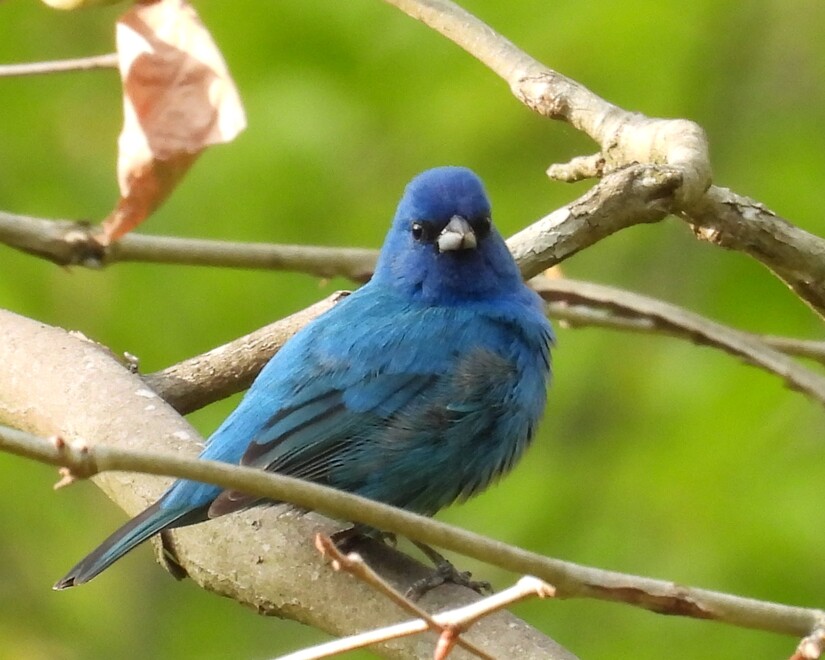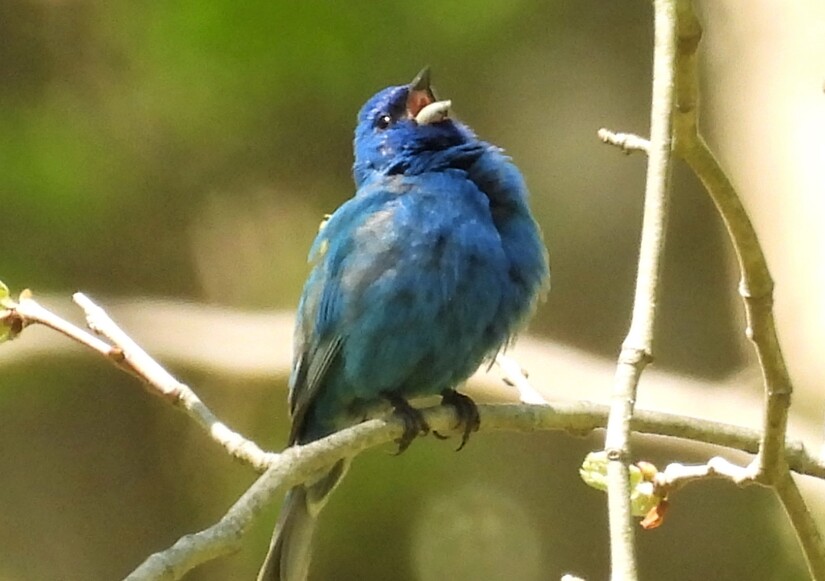Image

by Michael Strzelecki*
The lovely, iridescent blue bird seen here is the male indigo bunting. It is one of Mother Nature’s most striking and resplendent offerings. It is also a fine example of Mother Nature pulling a sleight-of-hand on its viewers. While it appears bright blue, the indigo bunting is actually black as a bowling ball.

Birds attain feather coloration mostly through their diets. Birds can create yellows and reds and oranges, but there is nothing in their diets that allows birds to take on a blue color. To compensate, birds that appear to be blue actually have certain structural features in their feathers (a certain way protein molecules are arranged) that causes light waves to reflect blue. Slight variances in the protein molecule structures result in different hues of blue. This applies to all birds that are blue, including blue jays and bluebirds.
Like so many other female birds, female indigo buntings lost the color lottery. They are drab brown with a creamy underbelly and sometimes have a faint wisp of blue on the wings or tail. As a general rule, male birds of most species are brightly colored to attract the most desirable females, whereas the females of the species are usually duller or brown as to better camouflage while incubating eggs on a nest.
Indigo buntings arrive in the Boyertown area in April and May, coming from their wintering grounds in Central and South America. The older and more dominant males arrive first to stake out the best territories. The best places to see indigo buntings are in meadows and forest clearings - areas where they have access to the bugs and seeds of a field, yet close to the safety of nearby trees. I routinely see them in yards that back up to fields and where forested hiking trails cross fields or power-line clearings.

Unlike the more hyperkinetic warblers, indigo buntings show more patience with human presence and will often perch for a pose. They are active throughout the summer in the Boyertown area, even after spring mating. In August, the bright blue male indigo buntings will molt their breeding colors and reappear in a brown outfit, looking much like females. At this point, they usually turn south and head back to their equatorial wintering grounds.
The Gulf of Mexico presents an imposing - and lethal - barrier to mitigating birds. Unlike many other migratory birds that have to take a longer route around the gulf, indigo buntings are able to store enough body fat to make the continuous 600-mile voyage across the gulf without touching down. Indigo buntings migrate at night, guided by stars. They have an uncanny ability to continually revise their migration route to account for the changing positions of stars as they move across the sky.

The best way to see an indigo bunting is to learn their call and listen for them. It is a high-pitched, chit-chat pattern that lasts for about two seconds but continually repeats. Their call can be heard at this link:
https://www.allaboutbirds.org/guide/Indigo_Bunting/sounds#
* Mike Strzelecki is a freelance travel and outdoor writer, and 1981 graduate of Boyertown Area Senior High School. He writes from his home in Baltimore, Maryland. In his spare time, he joins his wife on adventures around the country observing and photographing birds.